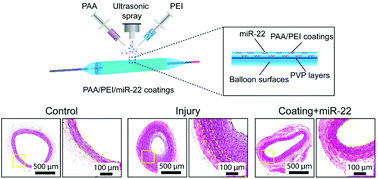Mir-22-incorporated polyelectrolyte coating prevents intima hyperplasia after balloon-induced vascular injury†
Abstract
Drug-coated balloons (DCBs) offer potential to deliver drugs to treat coronary lesions but without leaving permanent implants behind. Paclitaxel and sirolimus are anti-proliferation drugs that are commonly used in commercially available DCBs. However, these drugs present significant cytotoxicity concern and low efficacy in vivo. Here, we use microRNA-22 (miR-22) as balloon loaded drugs and polyelectrolyte complexes (PECs) polyethyleneimine/polyacrylic acid (PEI/PAA) as balloon coatings to establish a new DCB system through the ultrasonic spray method. The PEI/PAA forms a stable and thin coating on the balloon, which resulted in a good transfer capacity to the vessel wall both in vitro and in vivo. miR-22 that could modulate smooth muscle cell (SMC) phenotype switching is incorporated into the PEI/PAA coating and shows a sustained release profile. The PEI/PAA/miR-22 coated balloon successfully inhibits intima hyperplasia after balloon-induced vascular injury in a rat model through decreasing proliferative SMCs via the miR-22-methyl-CpG binding protein 2 (MECP2) axis. Our findings indicate that balloons coated with PEI/PAA/miR-22 have great potential to be promising DCBs in the treatment of cardiovascular disease.



 Please wait while we load your content...
Please wait while we load your content...